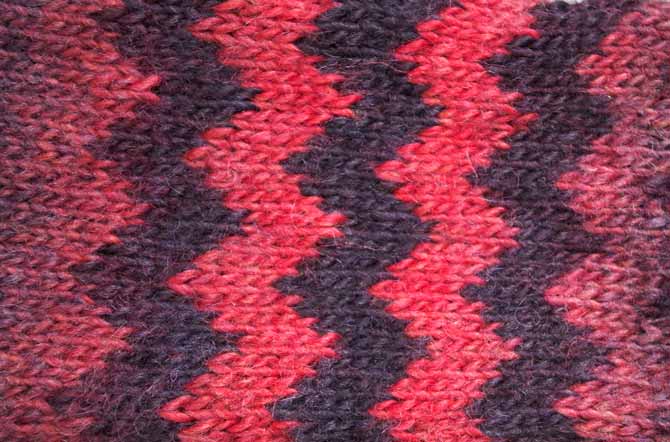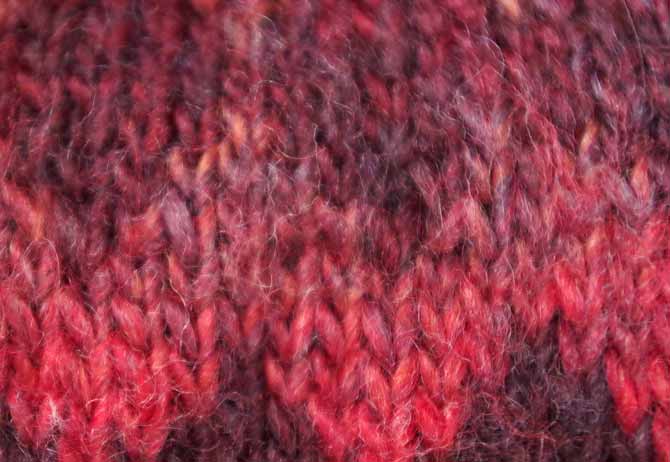So many different multicolored yarns are available in shops and from online stores these days. There are speckled, dip-dyed, kettle dyed, and gradient, marled, variegated, ombre, and long-repeat. Each one of these has different characteristics but all look good, especially in the skein. Knit up though, some of these yarns disappoint certain knitters.
This week, I got to try Classic Shades worsted weight yarn by Universal Yarns. I really enjoyed working with these long repeat yarns and they didn’t disappoint.

Skein of Classic Shades worsted weight yarn in the Fern colorway
This single-ply yarn comes in 29 colorways. Some are “safe” and “standard”, some are wildly surprising, but all are beautiful. When I look closely at the different colorways, I notice four different tendencies in the way the colors transition to each other.

4 different swatches of Classic Shades yarn showing different patterns in the way the repeats are spaced
Some of the colorways have long repeats that only cover a few rows of knitting. If you have a lot of stitches over the width of the knit piece, the stripes become narrower. They appear to be fairly random, or at least it takes longer to cycle through the color pattern repeat. In addition, each color is quite pure. There’s no tweedy or marled look to the knitting and the transitions from one color to another are very quick. Campfire, in the above photo, is an example of this.
A second tendency is to vary the lengths of each color in the colorway. These swatches show a few narrow stripes and then longer swaths of other colors. In the wider stripes, some of the stitches near the beginning of a transition are slightly tweedy or marled. Cool Blazes is an example.
Fern, the third example, shows a dye pattern with fewer colors and more marled stitches (marling is where you see a strong contrast between the two transitioning colors in the way they twist together).
Neon Lime Surprise is an example of the fourth tendency I noticed, where dark colors are grouped apart from bright colors, which creates a strong varied look in the overall finished fabric.
Campfire was my sample yarn. I started a small swatch of about 25 stitches. I knew that my stripes would be quite wide, but I wanted to see how the transitions would look over just a few stitches. I really like how the colors shifted very gradually from one to another. Some of this is due to the way the unspun fibers are blended and spun to create the slight marled effect that occurs in some short sections of the yarn. The bright blip of red a few rows below that garter stitch ridge is an example of a marled stitch.

Close up of Classic Shades in the Campfire colorway
The next thing I did was unravel the skein and look for the pattern repeat. Even after unravelling more than half the skein, I couldn’t find the true repeat in the color cycle, which to me was great, as a project knit out of Classic Shades would have the randomness I like to see in long color repeats.
My next experiment was to start a two-color pattern using a stranded knitting (or Fair Isle) technique where each color is drawn from a different starting point in the series of long color repeats. This is the result:

Closeup of stranded colorwork swatch worked from different points in the colorway – one light and one dark
I think that lots of experimentation and swatching will be necessary to ensure that I never have both yarns be the same color at the same time. It got pretty close to that when you look at the swatch below. To avoid this in the future, I will take apart 2 different skeins until I find the same starting point in the long color repeats series and then move to the next color on one of the yarns and then start the stranded knitting pattern. That way, I’d avoid running the risk of the same colors being together on a Fair Isle pattern. Of course, I could always break the yarn and wind off a section of yarn to get to the next high-contrast area.

Close up of zigzag pattern where colors are too similar.
Universal Yarns provides some free and some for-sale patterns that show other ways to use long-repeat yarns successfully. One pattern uses entrelac technique. It’s amazing that this cowl is made from the same skein of yarn. I love the gradual color transitions from diamond to diamond. The wrap shows the effect over a greater number of diamonds.

Free entrelac cowl pattern using Classic Shades yarn
The Mojave River blanket pattern uses two different colorways, blending them to maintain a constant contrast between the two yarns, yet still leave an infinitesimal series of contrasts over the shifting color repeats.

Picture of Mojave River blanket using two different colorways of Classic Shades
I have just a couple skeins of Campfire, so I’m not sure what I’m going to make yet. But I’m sure I’ll think of something. Tomorrow we’ll look at another yarn in the Classic Shades family of yarns.

1 comment
Intarsia is a game changer with these yarns. Here’s what I do with them: http://www.ravelry.com/patterns/library/bargello-comfort-shawl, http://www.ravelry.com/patterns/library/starry-night-cowl-3, and http://www.ravelry.com/patterns/library/windowpane-cowl-2